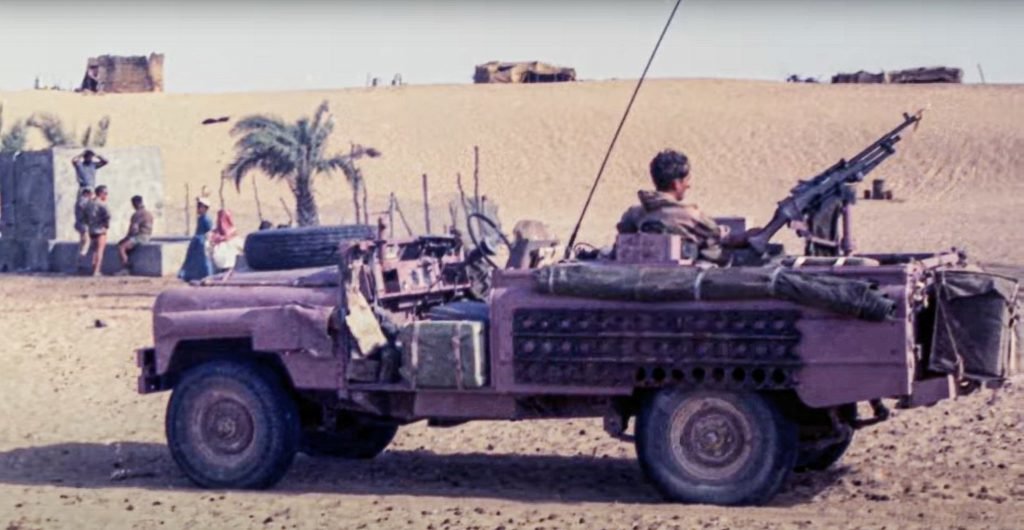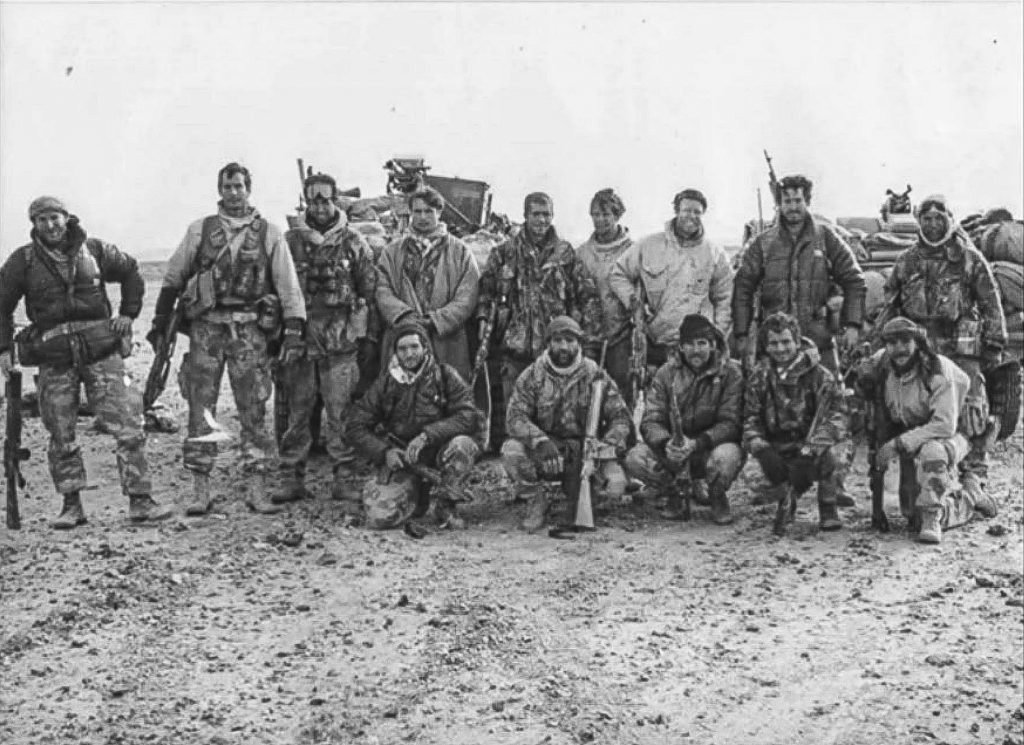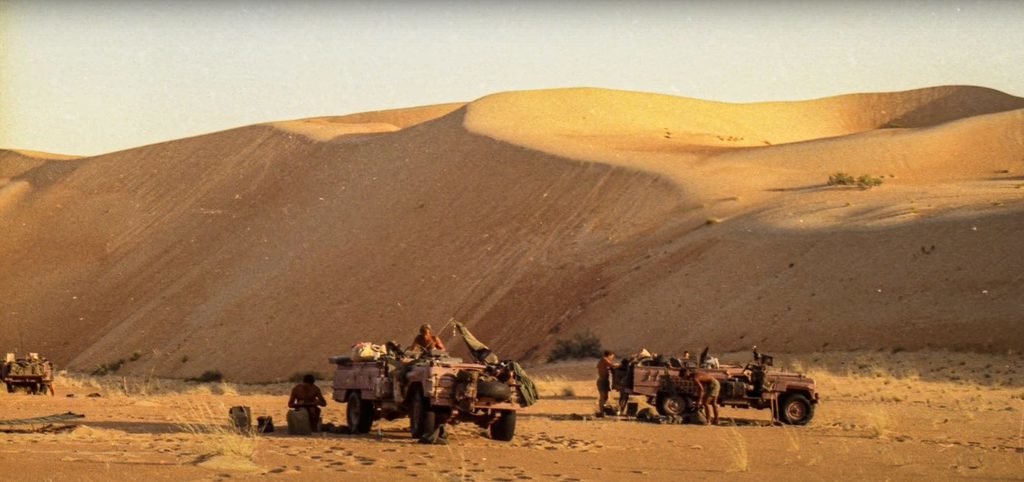‘The Pink Panthers’: Why the British SAS Used To Paint Their Camouflaged Land Rovers Pink

Colin Armstrong, better known by his pseudonym Chris Ryan, served with the British SAS and witnessed the transition from the so-called Pink Panthers or Pinkies to basic tan. Photo courtesy of @exsaschrisryan/Instagram. Composite by Coffee or Die Magazine.
Members of the British Special Air Service are considered masters of long-range mobility. Their first operations in the deserts of North Africa during World War II prioritized a need for an off-road vehicle capable of covering hundreds of miles across enemy terrain. In the 1960s and ’70s, further conflicts across the Middle East called for more long-range reconnaissance operations and search and destroy missions. The off-road vehicles favored by SAS mobility troops for operating in these austere environments were the “Pink Panthers” or “Pinkies” — Land Rovers painted in pink camouflage.
We reached out to British SAS veteran Colin Armstrong, better known under his pseudonym Chris Ryan — the author of more than 74 novels and recipient of the Military Medal — to learn more about these peculiar Land Rovers.
Armstrong is an expert in long-range mobility and first gained notoriety in 1991 for surviving the longest escape and evasion in SAS history. After his Bravo Two Zero team became compromised in Iraq, Armstrong traveled some 200 miles on foot over eight days and seven nights across the border into Syria. He was the only one in his team of eight to escape.
During his 10 years of service with the 22 SAS Regiment, Armstrong has had countless other experiences involving long-range mobility. He was also in the regiment during the transition between the original Land Rover Series II 109 Pink Panthers to the sand-colored 110 Land Rovers used in the Gulf War.

Armstrong explained how the SAS first took 109 Land Rovers to a company called Marshalls in Cambridge, England, where the vehicles were adapted to fit the regiment’s unique needs.
“The first thing they actually did was strip them down, take the roof off, the doors off, strengthen the suspension, the undercarriage,” Armstrong told Coffee or Die Magazine. “They started looking at how they could strap equipment on there, or more importantly, the weapons systems.”
A three-member crew had to be self-sufficient to survive for up to three months on their own. The commander, who also served as the navigator on the Land Rover, had double 7.62mm general-purpose machine guns on a movable pad. Behind him, another crew member handled either a double set of machine guns or a .50-caliber machine gun. On the Land Rover’s exterior were sand tracks or metal sheets with holes cut out to provide traction. If the vehicle got bogged down in deep sand, a SAS engineer could put them under the wheels and get out of virtually any situation.
“They would put all the spare wheels front and back, and that would help in case you crashed into something — it was protection,” Armstrong said. “They put fuel tanks onto this vehicle, which was 100 gallons, and that would give you a range of over 1,000 miles. You had jerrycans of water beside you, and it was basically to balance out the vehicle for moving across the desert.”

When these glorified gun trucks left the factory, they were painted green. Anyone with a brain cell understands green is a bull’s-eye in desert environments, so the SAS searched for alternative camouflage.
According to Armstrong, the origin story of how these Land Rovers gained their quirky pink camouflage is murky at best. The story goes that an aircraft had been painted pink so if the plane crashed or ran out of fuel in the desert, the recovery team could easily acquire the aircraft. However, when the first pink plane crashed, the search parties took forever to find it.
“The pink just blended into the desert,” Armstrong told Coffee or Die. “I’ve seen this in Botswana when we were in Okavango — now these things stick out like a snooker ball on a table. When you’re standing next to them, you think, ‘This can’t be right,’ but once you get it on the ground, especially in Oman, Jordan, and Yemen, where a lot of the rocks in the features are a pinky red, they were used with great effect.”

In 1991, the SAS transitioned from the pink-camouflaged 109 Land Rovers to the sand-camouflaged 110 Land Rovers.
“The first time I saw them in action was in the first Gulf War, where A and D Squadron were working in half squadron formations,” he said. “And they deployed in there, and they wreaked some devastation throughout that conflict, to the point of, they were having to tell the guys from the squadrons to slow down because you’re just destroying too much.”
Despite the change in appearance, the SAS Land Rovers kept their nicknames, the Pinkies and Pink Panthers, leaving many of the younger SAS troops wondering why the vehicles were called such names despite their tan color.
“You’d get young guys going, ‘Why do we call these Pinkies?’” Armstrong said and laughed. “And you’re like, ‘Read some history, son.”
Read Next: WATCH: British Pathfinders Take Skills From World War II Into Afghanistan

Matt Fratus is a history staff writer for Coffee or Die. He prides himself on uncovering the most fascinating tales of history by sharing them through any means of engaging storytelling. He writes for his micro-blog @LateNightHistory on Instagram, where he shares the story behind the image. He is also the host of the Late Night History podcast. When not writing about history, Matt enjoys volunteering for One More Wave and rooting for Boston sports teams.
BRCC and Bad Moon Print Press team up for an exclusive, limited-edition T-shirt design!
BRCC partners with Team Room Design for an exclusive T-shirt release!
Thirty Seconds Out has partnered with BRCC for an exclusive shirt design invoking the God of Winter.
Lucas O'Hara of Grizzly Forge has teamed up with BRCC for a badass, exclusive Shirt Club T-shirt design featuring his most popular knife and tiomahawk.
Coffee or Die sits down with one of the graphic designers behind Black Rifle Coffee's signature look and vibe.
Biden will award the Medal of Honor to a Vietnam War Army helicopter pilot who risked his life to save a reconnaissance team from almost certain death.
Ever wonder how much Jack Mandaville would f*ck sh*t up if he went back in time? The American Revolution didn't even see him coming.
A nearly 200-year-old West Point time capsule that at first appeared to yield little more than dust contains hidden treasure, the US Military Academy said.












